Gear Reviews
REVIEW – Miura Guitars U.S.A. M2 Compressor/Limiter Pedal
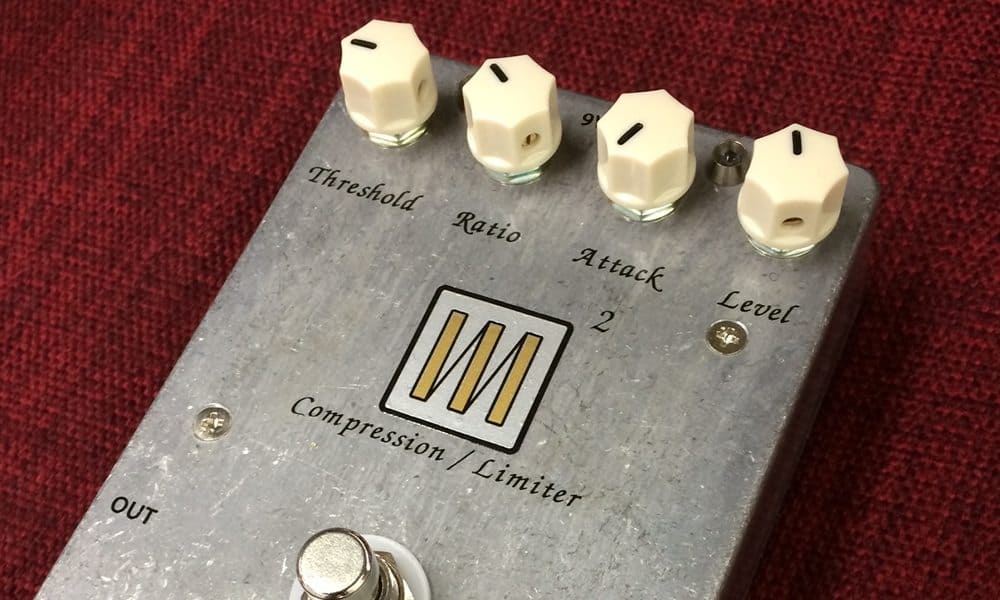
Long a maker of fine guitars and basses, Hiro Miura jumped into the world of effects pedals with the launch of the Miura M2 Compressor/Limiter.
Unveiled at Winter NAMM 2017, only 40 of the hand-made pedals are currently available through select dealers and retail at $280.
Following his company’s motto of “Never complete, keep evolving,” Miura believed it was time to take compressors to the next level and focus on creating an effect that didn’t kill the lower frequencies.
We wanted to make a compressor pedal that doesn’t squeeze the tone with attack,” said Miura. “We also didn’t want to over-compress the low B.”
Why use a compressor?
Compressors and limiters are used to reduce large swings in dynamics and to prevent your signal from distorting or clipping. In a way, they act like a bit of sonic insurance when it comes to dynamics — which is why they are often used when playing slap bass.
When used sparingly, compressors can also enhance bass tone by increasing sustain and creating a more defined, “sweeter,” note.
Enter the M2

The Miura M2 Compressor/Limiter comes out of the box looking like it’s ready to go to work. No enamel paint. No fancy artwork. Just a sturdy stomp box ready for today’s working bassist.
The box measures 3.75” x 4.75” x 1.375” and has some heft to it — but not the kind of weight that makes you wish you left it at home. The pedal gives you a solid feeling that you can take it on stage and stomp on it for years without a hiccup.
The pedal has an input and output impedance of 1Mohm and is powered by a DC9V (power supply not included).
M2 controls
The white control knobs are easy to see when lighting is at a minimum and the contrasting black indicator lines won’t leave you guessing where your settings are.
A blue LED in the top left tells you when the compressor is engaged. The blue LED on the right indicates the compressor strength. The light gets brighter the more the compressor is working.
Threshold sets the volume level for when the compression effect is engaged. With the dial all the way to the left, compression kicks in with the weakest of inputs. All the way to the right will affect only the stronger signals. You can adjust the threshold based on how much of your dynamic range you want altered by the compressor. You can choose to have most of your notes compressed or just the loud ones.
Ratio determines how much compression is applied to the signal above the threshold. Common ratios are 2:1 to 20:1, with the 2:1 and 5:1 being the most popular with bassists. To put this in context, for every two decibels going into the compressor only one decibel above the threshold goes out in a 2:1 ratio. The higher the ratio, the more compressed the signal is and the more “squished” the sound.
The Miura starts at 1:1 ratio with the control turned all the way to the left. With the dial at noon, the ratio is about 5:1 and maxes out at 9:1 with the dial all the way to to the right.
Attack describes when the compression effect kicks in once the signal crosses the threshold. A longer attack creates a more natural sounding note and a shorter attack chokes the note by having compression engage sooner. The M2 attack ranges from 220 microseconds to 100 milliseconds.
While some pedals offer an adjustable Release to control how long the compressor affects the signal, the M2 is fixed at 22 milliseconds. “We chose the release time based on where we didn’t want the sound to distort when using the low B,” said Miura.
Review
I loaned the review model to an experienced pedal guru, Derek Jones, for his take on the M2. As a veteran session bassist and long-time musician for the Cirque du Soleil production KA at the MGM Grand in Las Vegas, he put the pedal through its paces.
“I’ve used several compression pedals over the years and the M2 really brings out some nice qualities of the bass to the mix,” he said. “It’s really a musical piece of equipment.”
“It’s what I call a ‘shoulders down’ piece of gear. It makes you feel comfortable and relaxed to play through because you’re not thinking about the pedal during a gig. I’d have this on at the beginning of my signal chain and not worry about it.”
Since it’s not easy to translate a compressor into words, it’s probably best to use your ears and decide for yourself.
The sound clips are divided into five categories of finger, pick, slap (with my apologies to slappers), chords, harmonics, and fretless. Each category repeats the line with no compression, light compression, moderate compression (noon on the dial) and heavy compression. All other controls were set at the starting point recommended by Miura: Threshold at 9:00, Ratio at noon, and Level at noon.
The clips are intentionally at a slower tempo to let you better hear the pedal in action.
If have trouble hearing clips, click to listen
Next steps
Miura’s plans include the introduction of a bass pre-amp DI later this year. The pre-amp will use a transformer designed specifically to enhance bass frequencies.
In the meantime, you can try out the M2 Compressor/Limiter by purchasing it directly from Miura Guitars U.S.A. or through any one of their international dealers.
Bass Videos
String Instrument Humidifiers
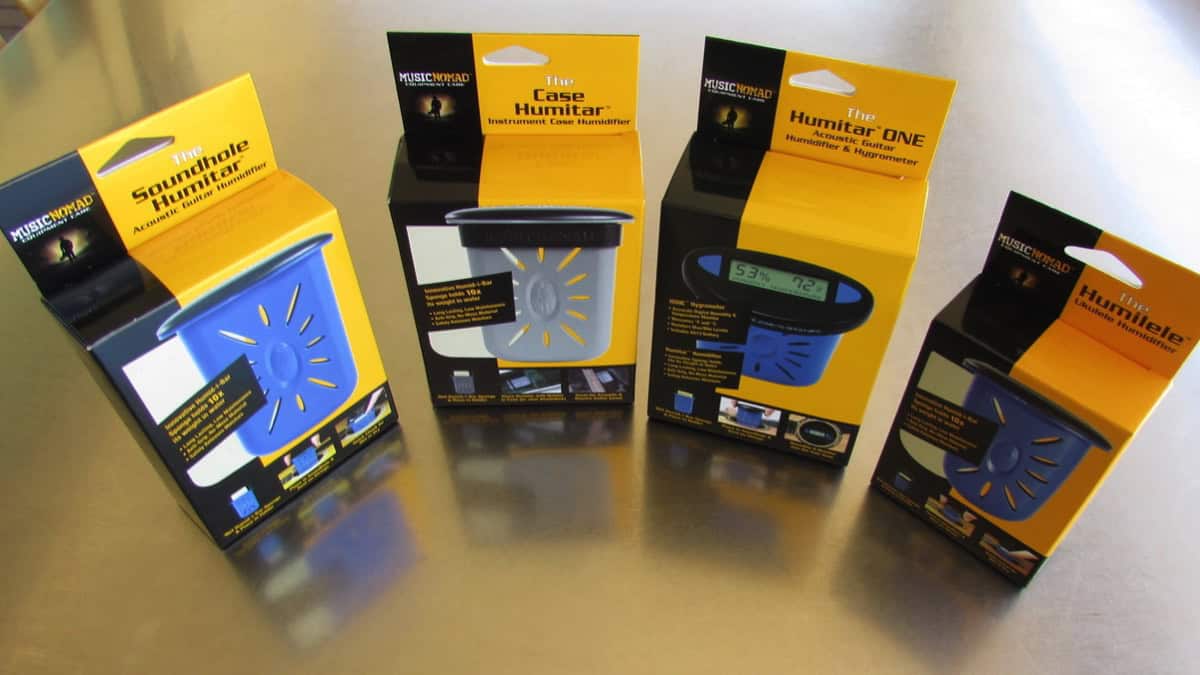
String Instrument Humidifiers
After living in some very humid parts of the country for decades, we moved to a dryer, much sunnier location. As a result, I started noticing some fret sprout on my string instruments and recently did a video on fret sprout correction.
It occurred to me that I should take a more preventative approach to string instrument humidification. Of course, I turned to my instrument maintenance experts, Music Nomad Equipment Care, for a solution and they suggested their Humitar series. (Note: They sent two press samples and I purchased the remainder online.)
Join me as I look at these useful tools for keeping my string instruments in tip-top condition.
The Humitar series is available online at Music Nomad Equipment Care, as well as Amazon.com
Bass Videos
Review: CrystalBright Rombo Picks
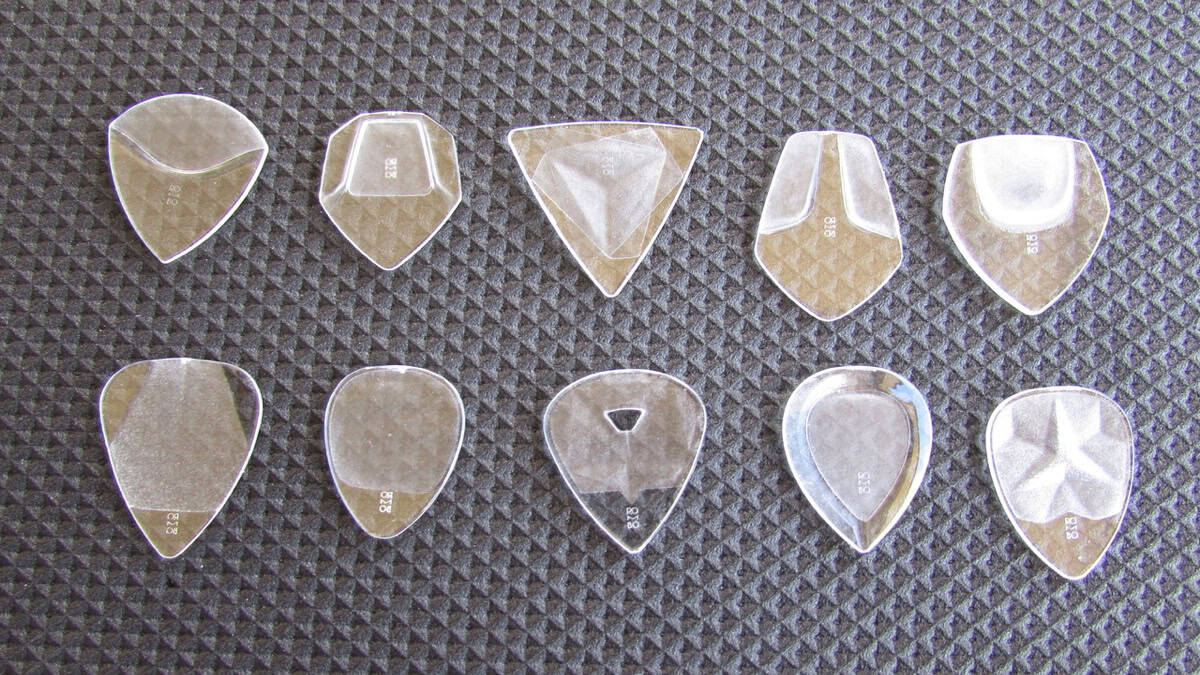
CrystalBright Rombo Picks
PR SamplePlaying bass with a pick is still a touchy subject in our community. I believe you should be able to use whatever you need to get your sound. Even though I mostly play with my fingers, I like to check out innovative new picks that might have something new to offer, sonically speaking.
Judith and Carlos from Rombo recently contacted me about a new material called CrystalBright that they have been researching for the last 12 months and offered to send some prototype picks. After trying them out, I put together this video with my findings.
For more info check out @rombopicks
Gear
New Joe Dart Bass From Sterling By Music Man

Sterling by Music Man introduces the Joe Dart Artist Series Bass (“Joe Dart”), named after and designed in collaboration with the celebrated Vulfpeck bassist.
Above photo credit: JORDAN THIBEAUX
This highly-anticipated model marks the debut of the Dart bass in the Sterling by Music Man lineup, paying homage to the Ernie Ball Music Man original that all funk players know and love. The bass embodies many of the original model’s distinctive features, from its iconic minimalist design to the passive electronics.

The design process prioritized reliability, playability, and accessibility at the forefront. Constructed from the timeless Sterling body, the Dart features a slightly smaller neck profile, offering a clean tone within a comfortable package. The body is crafted from soft maple wood for clarity and warmth while the natural finish emphasizes the simple yet unique look.
Engineered for straightforward performance, this passive bass features a ceramic humbucking bridge pickup and a single ‘toaster’ knob for volume control. Reliable with a classic tone, it’s perfect for playing in the pocket. The Dart is strung with the all-new Ernie Ball Stainless Steel Flatwound Electric Bass Strings for the smoothest feel and a mellow sound.

The Sterling by Music Man Joe Dart Bass is a special “Timed Edition” release, exclusively available for order on the Sterling by Music Man website for just one month. Each bass is made to order, with the window closing on May 31st and shipping starting in November. A dedicated countdown timer will indicate the remaining time for purchase on the product page. Additionally, the back of the headstock will be marked with a “2024 Crop” stamp to commemorate the harvest year for this special, one-of-a-kind release.
The Joe Dart Bass is priced at $399.99 (MAP) and can be ordered globally at https://sterlingbymusicman.com/products/joe-dart.
To learn more about Joe Dart, visit the official Vulfpeck artist site here https://www.vulfpeck.com/.
Gear Reviews
The Frank Brocklehurst 6-String Fretless Bass Build
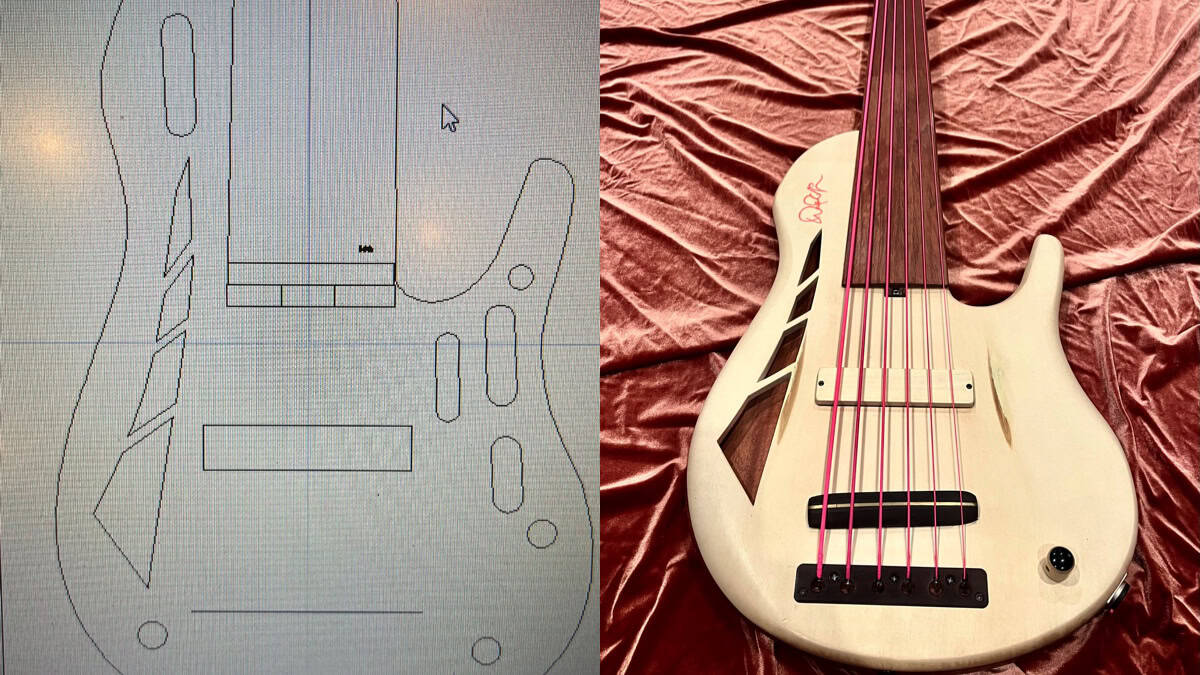
A few months ago, my Ken Bebensee 6-string fretted bass needed some TLC. You know, the one rocking those Pink Neon strings! I scoured my Connecticut neighborhood for a top-notch luthier and got pointed to Frank Brocklehurst, F Brock Music. He swung by my place, scooped up the bass, and boom, returned it the next day, good as new. Not only that, he showed up with a custom 5-string fretted bass that blew me away. I couldn’t resist asking if he could whip up a 6-string fretless for me.
Alright, let’s break down the process here. We’ve got our raw materials: Mahogany, Maple, and Holly. Fun fact – the Mahogany and Maple have been chilling in the wood vault for a solid 13 years. Frank is serious about his wood; they buy it, stash it away, and keep an eye on it to make sure it’s stable.

First up, they’re tackling the Mahogany. Frank glues it together, then lets it sit for a few days to let everything settle and the glue to fully dry. After that, it’s onto the thickness planer and sander to get it nice and flat for the CNC machine. The CNC machine’s the real star here – it’s gonna carve out the body chambers and volume control cavity like a pro.

While the Mahogany’s doing its thing, Frank goes onto the neck core. Three pieces of quartersawn maple are coming together for this bad boy. Quartersawn means the grain’s going vertical. He is also sneaking in some graphite rods under the fingerboard for stability and to avoid any dead spots. The truss rod is going to be two-way adjustable, and the CNC machine’s doing its magic to make sure everything’s just right.

Now, onto the design phase. Frank uses CAD software to plan out the body shape, neck pocket, chambering, and those cool f-holes. I had this idea for trapezoid F-holes, just to do something different. The CAD software also helps us map out the neck shape, graphite channels, and truss-rod channel with pinpoint accuracy.

Once everything’s planned out, it’s CNC time again. Frank cuts out the body outline, neck pocket, and the trapezoid F-holes. Then it’s a mix of hand sanding and power tools to get that neck just how we like it. Oh, and those f holes? We’re going for trapezoids of different sizes – gotta keep things interesting.

Next step: gluing that neck into the pocket with some old-school hide glue. It’s got great tonal transfer and can be taken apart later if needed. Then it’s onto hand-carving that neck-body transition.

For the custom-made bridge, Frank uses brass for definition and Ebony for tonal transfer and that warm, woody sound.

BTW, for tunes, Frank went with Hipshot Ultralights with a D Tuner on the low B. This way I can drop to a low A which is a wonderful tone particularly if you are doing any demolition around your house!
Now it’s time for the side dots. Typically, on most basses, these dots sit right in the middle of the frets. But with this bass, they’re placed around the 1st, 3rd, 5th, 7th, 9th, and 12th frets.

Frank’s got his pickup hookup. Since the pickup he was building wasn’t ready, he popped in a Nordstrand blade to give it a whirl.

It sounded good, but I was itching for that single-coil vibe! And speaking of pickups, Frank showed me the Holly cover he was cutting to match, along with all the pink wire – talk about attention to detail!

A couple of things, while it is important for me to go passive, it is equally important for me to just go with a volume knob. Tone knobs are really just low-pass filters and the less in the way of a pure sound for me, the better.
Finally, it’s string time! As usual, I went for the DR Pink Neon strings. Hey, I even have matching pink Cons…Both low tops and high!

Once we’ve got everything tuned up and settled, we’ll give it a day or two and then tweak that truss rod as needed. And voila, we’ve got ourselves a custom-made bass ready to rock and roll.

I want to thank Frank Brocklehurst for creating this 6 string beast for me.
Gear Reviews
Review Transcript: BITE Custom Bass – The Black Knight PP Bass
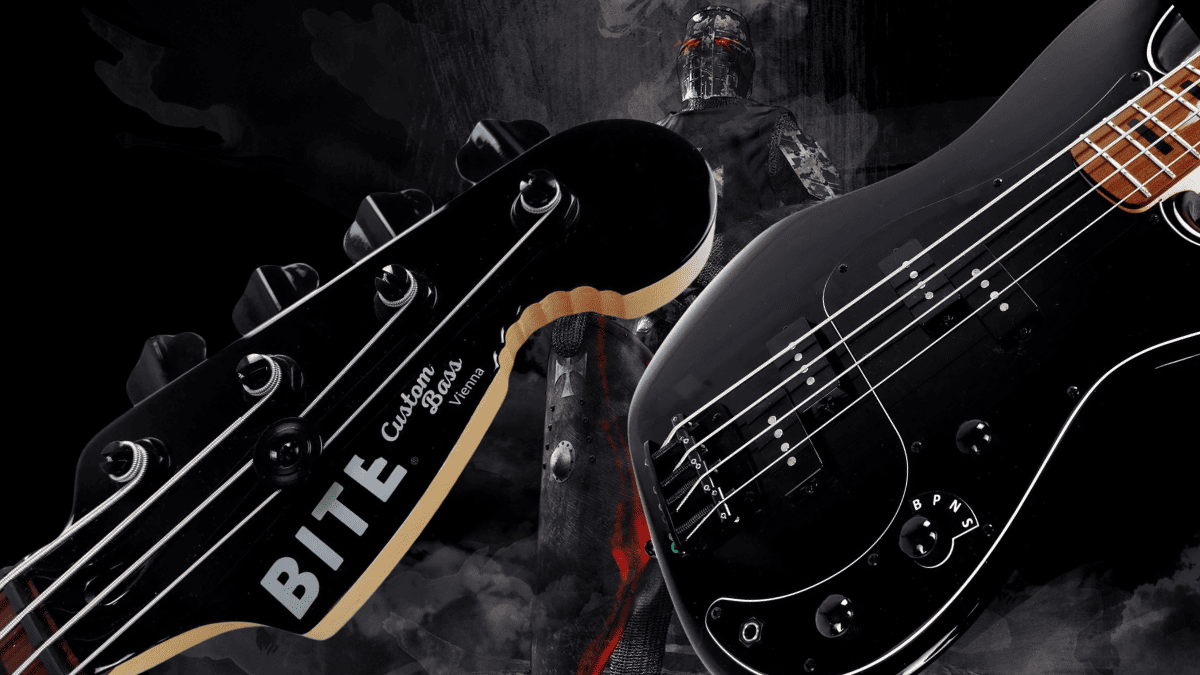
This is a written transcript of our video review of the BITE Custom Bass Black Knight PP Bass originally published on March 4, 2024
BITE Custom Bass – The Black Knight PP Bass Review…
Bass Musician Magazine did a review on a Steampunk bass from BITE Guitars about three years ago, it was an amazing instrument, and we were very impressed. Now we’re happy to bring you another BITE bass, the Black Knight PP.

Everybody needs a P-type bass, it’s the standard of bass. If you’re recording, they want you to have a P bass. So why not have something that gives you a little more by having two instead of one P pickup. That’s the idea of this bass, it’s the first thing that leaps out: the double P pickup configuration.

Installing two of their 1000 millivolt split-coil pickups, BITE then went one step further and wired them up in a 4-way parallel/series circuit, a look at the controls reveal a 4-way rotary selector:
The first position, marked “B”, gives you the bridge pickup by itself.
The second position, marked “P”, gives you the bridge and neck pickups in parallel mode, that’s the traditional J-type circuit, it reduces output due to the physical law of parallel circuits.
Position number 3 is marked “N”, it gives you the neck pickup by itself.
And finally, number 4, marked “S”, gives your bridge and neck in a series (humbucking) mode which adds up resistances and thus boosts output. The other two controls are master volume and master tone.

What’s more, like every BITE bass, this one also has a reinforced headstock heel designed to give it extra output and sustain. The BITE website features a graph and explanation of what they have done to the heel, as compared to traditional headstocks.

A look at the body reveals a beautiful Black Blast body finish and underneath that we have alder wood. The bass has a matching headstock with a 4-in-line tuner setup and the traditional bite out of it, so everybody will know what kind of bass you’re playing. The pickguard is 3-ply black, the neck is vintage tinted hard maple and it has a satin speed finish at the back which keeps your thumb from sticking.
On top of that, there’s a clear-coated roasted black locust fretboard with black blocks marking the frets. The nut is a black Graph Tec nut, we’ve got diamond dome control knobs, and the tuners are lightweight compacts with cloverleaf buttons and a 1:17 ratio precision gear. The bridge is a Gotoh brass bridge with 19-millimeter string spacing.
Overall measurements: we’ve got a standard 34″ scale, a 1.65″ width nut and a C neck profile. This bass weighs 8.2 pounds, or 3,7 kilograms for our metric friends, and it uses standard 18% nickel silver frets.
Taking a closer look at the sound, this bass is a joy to play. The BITE proprietary 1000 millivolt pickups deliver an extraordinary amount of output which is surprising considering this is a passive instrument. You may even want to set your amp to active mode because of all of the juice you’re getting out of this guy.
The tonal possibilities are very versatile, it’s a straight P if you want but also much more with those different arrangements of the circuitry. So why have multiple basses when you’ve got one that can give you your basic P plus a lot more?
To sum it up, the Black Knight PP is an amazing instrument. The attention to detail that BITE puts into their basses is second to none. This bass is also amazingly balanced and gorgeous to hold and feel with the satin neck finish.
For more information, visit online at bite.guitars/product/black-knight-pp








